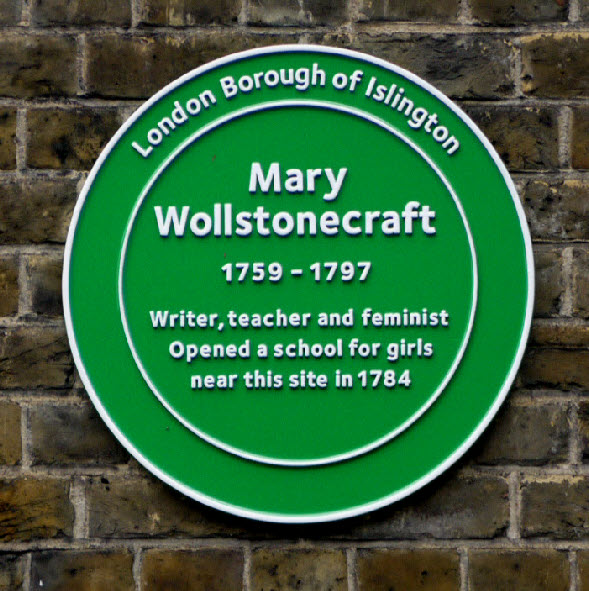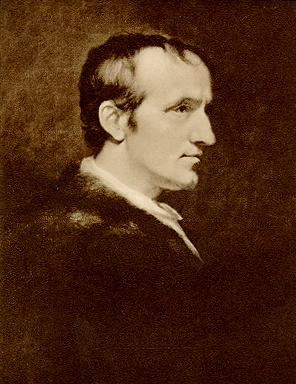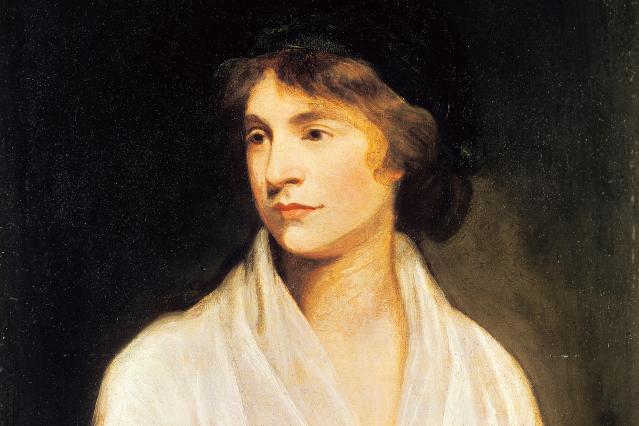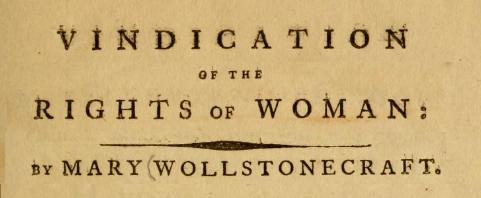“It is time to effect a revolution in female manners…and make them, as a part of the human species…For man and woman, truth, if I understand the meaning of the word, must be the same… Women, I allow, may have different duties to fulfil; but they are human duties, and the principles that should regulate the discharge of them, I sturdily maintain, must be the same.”
(Mary Wollstonecraft, A Vindication on the Rights of Women, Chapter III)
Today we celebrate one of the first feminists in modern Western history, a woman whose remarkable life and impressive intellect were forgotten for nearly a century, and woman whose work is still surprisingly relevant to this day–Mary Wollstonecraft, who was born this day in 1759.
In her most famous work, A Vindication on the Rights of Women, Wollstonecraft essentially argued that men and women were born and meant to be equals, but that society, and its refusal to train women’s brains and bodies properly, were forcing women into a subservient role, and ensuring that they would never be anything more than a pretty face. It wasn’t appreciated until much later how much of her writings were inspired by her own life, and her incredibly difficult childhood.
 Wollstonecraft was the the second of the seven children of Edward John Wollstonecraft and Elizabeth Dixon. Though the family was initially financially comfortable, her father squandered most of the money on speculative investments and, later, alcohol, including inheritance money that should have gone to Mary. He was abusive, as well, and Mary as a teenager often lay on the floor outside her mother’s bedroom at night to ensure that her father couldn’t get inside. Things changed for the better when Mary was introduced to Frances (Fanny) Blood, who encouraged her to improve her life through education, and gave her all the personal and intellectual support she could not get at home.
Wollstonecraft was the the second of the seven children of Edward John Wollstonecraft and Elizabeth Dixon. Though the family was initially financially comfortable, her father squandered most of the money on speculative investments and, later, alcohol, including inheritance money that should have gone to Mary. He was abusive, as well, and Mary as a teenager often lay on the floor outside her mother’s bedroom at night to ensure that her father couldn’t get inside. Things changed for the better when Mary was introduced to Frances (Fanny) Blood, who encouraged her to improve her life through education, and gave her all the personal and intellectual support she could not get at home.
Mary determined to become self-supportive around the age of nineteen, and, after working as a ladies maid for several years, opened a school with Fanny Blood in Newington Green in London (that’s right…Mary Wollstonecraft and I were neighbors!). The school was a rousing success, but Fanny and her husband soon moved to Portugal in the hopes of improving Fanny’s health, and Mary abandoned the school to help care for her until her death in 1787.

Though a gifted educator, Mary decided that she was done scrabbling for money and being at the mercy of other people to provide her with a living. Taking an enormous financial and social risk, she decided to become an author, a career that very few women chose at that time. She moved to London, and became a trusted and valued member of a number of intellectual circles, making friends with Samuel Johnson and Thomas Paine, among others. Following the end of an affair with the (married) artist Henry Fuseli, Mary moved to France, eager to be a part of the intellectual, as well as the political revolution that was fomenting there (she had proposed to share Henry, but apparently Mrs. Fuseli was not agreeable to such a proposal.).
It was around this time that Mary penned A Vindication on the Rights of Women, published in 1792, which was a follow-up to her 1790 pamphlet A Vindication on the Rights of Man, in which she argued against class divisions and the aristocracy and championed the Republican sentiments that were spreading across the newly-founded United States and France.
It was her passionate argument for women, however, that made Mary famous. In A Vindication on the Rights of Women, she rejected outright the notion that women’s minds were incapable of rational thought or unfit to be educated, and that their bodies were too weak to allow them to work, or be independent from men. As she describes, “Fragile in every sense of the word, [women] are obliged to look up to man for every comfort… I am fully persuaded that we should hear of none of these infantile airs, if girls were allowed to take sufficient exercise, and not confined in close rooms till their muscles are relaxed, and their powers of digestion destroyed.”
She argued that “females…are made women of when they are mere children”, meaning that girls were taught from a very young age that their only worth lay in physically attracting a man. The result was that women were forced to remain like children for the rest of their lives. It was not their natural inclination to be so, but the way in which they were brought up:
False notions of beauty and delicacy stop the growth of their limbs and produce a sickly soreness…and thus weakened …how can they attain the vigour necessary to enable them to throw off their factitious character?—where find strength to recur to reason and rise superiour to a system of oppression, that blasts the fair promises of spring? This cruel association of ideas, which every thing conspires to twist into all their habits of thinking, or, to speak with more precision, of feeling, receives new force when they begin to act a little for themselves; for they then perceive that it is only through their address to excite emotions in men, that pleasure and power are to be obtained. Besides, the books professedly written for their instruction, which make the first impression on their minds, all inculcate the same opinions. Educated then in worse than Egyptian bondage, it is unreasonable, as well as cruel, to upbraid them with faults that can scarcely be avoided…when nothing could be more natural, considering the education they receive, and that their ‘highest praise is to obey, unargued’—the will of man.
This is not to say that Wollstonecraft’s work was and remains utterly unassailable–A Vindication on the Rights of Women is full of class and gender assumptions, many the result of religion, that date the work considerably. But her argument for the absolute equality of human beings remains a remarkable and moving statement that, largely, is still relevant today.
 Mary had her first daughter, Fanny, with an American named Gilbert Imlay, whom she met in France. They were never married (though they claimed to be so that Mary could escape the Revolutionary government in France), and Imlay soon dropped out of Mary’s life, leading to a very serious battle with depression. Several years later, in 1797, she married the writer and philosopher William Godwin (pictured at left), and the two moved into adjoining houses so that they could maintain their complete independence, and frequently corresponded by letter. Their marriage, by all accounts, was a happy one, but it was also brief. Mary died of septicemia following the birth of her second daughter, Mary (who would become the author of Frankenstein).
Mary had her first daughter, Fanny, with an American named Gilbert Imlay, whom she met in France. They were never married (though they claimed to be so that Mary could escape the Revolutionary government in France), and Imlay soon dropped out of Mary’s life, leading to a very serious battle with depression. Several years later, in 1797, she married the writer and philosopher William Godwin (pictured at left), and the two moved into adjoining houses so that they could maintain their complete independence, and frequently corresponded by letter. Their marriage, by all accounts, was a happy one, but it was also brief. Mary died of septicemia following the birth of her second daughter, Mary (who would become the author of Frankenstein).
Following her death, Godwin published Mary’s unfinished memoirs, titled Memoirs of the Author of A Vindication of the Rights of Woman. Though Godwin honestly believed that Mary’s shockingly honest memoirs were the best way to memorialize her, the book was considered so scandalous (talking, as it did about her love affairs, single motherhood, depression, and suicide attempts, in very frank and thoughtful terms), that her reputation was demolished. It would be nearly a century before anyone seriously studied Mary’s works. However, in 1892, Millicent Garrett Fawcett, a prominent suffragette, wrote in an introduction to A Vindication on the Rights of Women, calling Mary the founder of the women’s movement. But don’t take her–or my–word for it. In honor of her birthday, have a look through Mary Wollstonecraft’s surprising and insightful work today (you can find the full transcription of the work here) and see for yourself!


